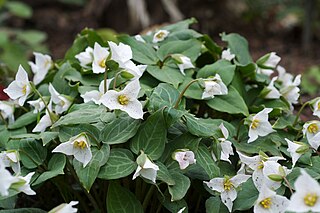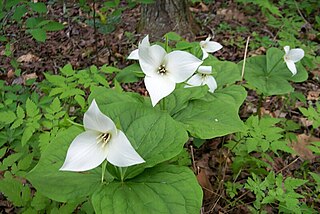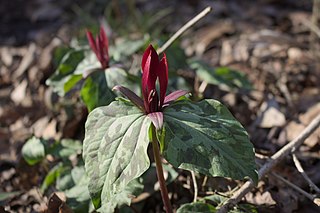
Trillium is a genus of about fifty flowering plant species in the family Melanthiaceae. Trillium species are native to temperate regions of North America and Asia, with the greatest diversity of species found in the southern Appalachian Mountains in the southeastern United States.

Trillium erectum, the red trillium, also known as wake robin, purple trillium, bethroot, or stinking Benjamin., is a species of flowering plant in the family Melanthiaceae. The plant takes its common name "wake robin" by analogy with the European robin, which has a red breast heralding spring. Likewise Trillium erectum is a spring ephemeral whose life-cycle is synchronized with that of the forests in which it lives. It is native to the eastern United States and eastern Canada from northern Georgia to Quebec and New Brunswick.

Trillium grandiflorum is a species of flowering plant in the family Melanthiaceae. A monocotyledonous, herbaceous perennial, the plant is native to eastern North America, from northern Quebec to the southern parts of the United States through the Appalachian Mountains into northernmost Georgia and west to Minnesota. There are also several isolated populations in Nova Scotia, Maine, southern Illinois, and Iowa.

Pseudotrillium is a monotypic genus of flowering plants in the family Melanthiaceae containing the single species Pseudotrillium rivale. The genus was proposed in 2002 on the basis of morphology and molecular evidence that suggest the plant should no longer be included in genus Trillium.

Trillium ovatum, the Pacific trillium, also known as the western wakerobin, western white trillium, or western trillium, is a species of flowering plant in the family Melanthiaceae. It is found in western North America, from southern British Columbia and the tip of southwestern Alberta to central California, east to Idaho and western Montana. There is an isolated population in northern Colorado and southern Wyoming.

Trillium luteum, the yellow trillium or yellow wakerobin, is a species of flowering plant in the bunchflower family Melanthiaceae with native populations in the Great Smoky Mountains of the United States and surrounding areas.

Trillium rugelii, also known as the southern nodding trillium or illscented wakerobin, is a species of flowering plant in the family Melanthiaceae. It is native to parts of the southeastern United States. It is found in the Great Smoky Mountains, Fernbank Forest, Steven's Creek Heritage Preserve, and other places of the Piedmont and southern Appalachian Mountains in Alabama, Georgia, South Carolina, North Carolina and Tennessee. It prefers to grow near streams in humus-rich soil under the shade of deciduous trees.

Trillium discolor, the mottled wakerobin, pale yellow trillium, or small yellow toadshade, is a species of flowering plant in the family Melanthiaceae. It is native to areas of the Savannah River drainage system of Georgia, North Carolina and South Carolina such as Steven's Creek Heritage Preserve and Lake Keowee. It is found along moist stream banks in upland woods, on acidic to basic soils.

Trillium flexipes, known as the nodding wakerobin, bent trillium, or drooping trillium, is a species of flowering plant in the family Melanthiaceae. It is found from Minnesota to Ohio, south to Tennessee, with isolated populations in New York, Pennsylvania, Alabama, and other states. It is an endangered species in Ontario and possibly extirpated in North Carolina.

Trillium simile, the jeweled wakerobin, is a spring-flowering perennial plant which is native to southern parts of the Appalachian Mountains in southeastern United States. It is also known as sweet white wake-robin, sweet white trillium and confusing trillium.

Trillium cuneatum, the little sweet Betsy, also known as whip-poor-will flower, large toadshade, purple toadshade, and bloody butcher, is a species of flowering plant in the family Melanthiaceae. It is native to the southeastern United States but is especially common in a region that extends from southern Kentucky through central Tennessee to northern Alabama. In its native habitat, this perennial plant flowers from early March to late April. It is the largest of the eastern sessile trilliums.

Trillium cernuum is a species of flowering plant in the family Melanthiaceae. It is the most northerly occurring species of Trillium in North America, occurring as far north as Hudson Bay. Its range extends across Canada, from Saskatchewan in the west to Newfoundland in the east, and as far south as northern Virginia. It occurs on rich, moist soils in both broadleaf and coniferous woodland.

Trillium nivale, the snow trillium or dwarf white trillium, is a species of flowering plant in the family Melanthiaceae. It is native to parts of the east and midwest United States, primarily the Great Lakes States, the Ohio Valley, and the Upper Mississippi Valley, as far north as central Minnesota.

Trillium decumbens, also known as the decumbent trillium or trailing wakerobin, is a species of flowering plant in the family Melanthiaceae. It is native to the southeastern United States, in Tennessee, Georgia, and Alabama, growing in mature deciduous woodlands or on open rocky wooded slopes.

Trillium pusillum is a species of flowering plant in the family Melanthiaceae known by the common names dwarf trillium, least trillium and dwarf wakerobin. It is native to the southeastern and south-central United States from Oklahoma to Maryland.

Trillium recurvatum, the prairie trillium, toadshade, or bloody butcher, is a species of perennial herbaceous flowering plant in the family Melanthiaceae. It is native to parts of central and eastern United States, where it is found from Iowa south to Texas and east to North Carolina and Pennsylvania. It grows in mesic forests and savannas, often in calcareous soils. It is also known as bloody noses, red trillium, prairie wake-robin, purple trillium, and reflexed trillium, in reference to its reflexed sepals.

Trillium gracile, commonly known as the Sabine River wakerobin, slender trillium, or graceful trillium, is a species of flowering plant in the family Melanthiaceae. It is native to the region along the Sabine River in western Louisiana and eastern Texas. It generally grows in mature pine and hardwood forests, and on riverbanks.

Trillium kurabayashii, the giant purple wakerobin, is a species of flowering plant native to the United States, in southwestern Oregon and northern California.

Trillium maculatum, the spotted wakerobin or spotted trillium, is a species of flowering plant in the family Melanthiaceae. It is found only in the eastern United States.
White trillium is a common name for Trillium grandiflorum, a flowering plant native to North America.


















